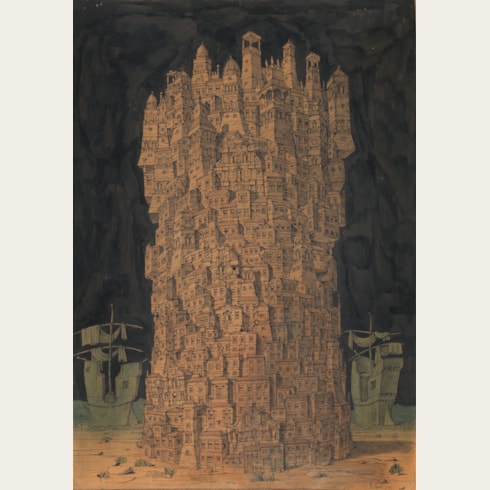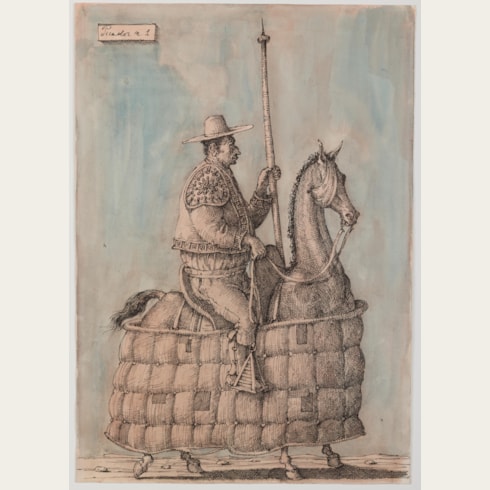Domenico GNOLI
(Rome 1933 - New York 1970)
Roman Dreamer
Sold
Pen and black and brown ink and black wash, over traces of a pencil underdrawing.
Signed and dated D. Gnoli / 59 near the upper right corner.
686 x 615 mm. (27 x 24 1/2 in.)
Signed and dated D. Gnoli / 59 near the upper right corner.
686 x 615 mm. (27 x 24 1/2 in.)
Drawn in 1959, the present sheet may be associated with a group of pen and ink drawings by Domenico Gnoli; a series of views of the markets and restaurants of the city of Rome, mostly seen from high above, dating from between 1958 and 1960. As the artist noted of four other large-scale drawings from the same series, ‘Here are four of my ‘Roman’ drawings - I say Roman, not of Rome or about Rome, because, just like me, they are Roman by nature, not by vocation. Four Roman drawings then, done with care, with pedantic precision - a sort of inventory of the elements of the Rome in which I grew, possibly more a Rome I remember than a Rome I know. An inventory of umbrellas, chairs, crates, the tables of the sidewalk cafes, fish and vegetables stocked in the shady intimacy of small markets, the solemn and dark laundries - everything, in short, that moves on the cobblestones of the narrow, unpredictable streets of the old Rome. And the smells, the noise, and then at last the night…the empty wine shops - the ‘osterie’ as we call them - with the odds-and-ends remaining from some informal gathering, some ready to close with the chairs on the tables so the floor can be swept, only one table still set with the chairs around it, for the tired waiters’ dinners…and then the noise ceases, but the voices go on - the exclamative, mocking wise voices of the Romans. The wise voices of a wise city, these are - of skeptical, calm citizens removed from all urgency, removed quite often from these drawings too, so that the settings of their tranquil lives may speak for themselves...’
As a Times review of the inaugural exhibition in London of Gnoli’s drawings, held at the Arthur Jeffress Gallery in 1957, noted, ‘Mr. Gnoli’s drawings are complex, fantasticated, and full of busy goings-on of a mildly satirical absurdity...The success of imaginative excursions of this sort depends largely on the ability of the never-never land that has been created to sustain a measure of internal plausibility by which even the most extravagant oddities become, in context, the correct and acceptable thing. The world of Mr. Gnoli’s drawings may seem a largely synthetic and artificial one, but it does establish a sense of its own private logic by its exorbitant amount of quite rational detail.’
Three years later, a brief mention in The Times of Gnoli’s second London exhibition at the same gallery - in which the present sheet was included, serving as the cover of the catalogue - singled out this large drawing in particular: ‘Mr. Dominic Gnoli’s last London exhibition was of fantasticated drawings in which the fantasy lay as much in the subject-matter as in the highly elaborate pen technique. The drawings and paintings in his exhibition now at the Jeffress Gallery, 28, Davies Street, are seemingly concerned with more ordinary – even with “realist” – subjects, such as washer-women, piles of baskets, crates or folded linen, deserted beaches, and buildings. But a sense of fantasy and light humour still pervades them, in none more pleasantly than in the “Roman Dreamer”, stretched at ease on the tiled roof of his curious house.’
As a Times review of the inaugural exhibition in London of Gnoli’s drawings, held at the Arthur Jeffress Gallery in 1957, noted, ‘Mr. Gnoli’s drawings are complex, fantasticated, and full of busy goings-on of a mildly satirical absurdity...The success of imaginative excursions of this sort depends largely on the ability of the never-never land that has been created to sustain a measure of internal plausibility by which even the most extravagant oddities become, in context, the correct and acceptable thing. The world of Mr. Gnoli’s drawings may seem a largely synthetic and artificial one, but it does establish a sense of its own private logic by its exorbitant amount of quite rational detail.’
Three years later, a brief mention in The Times of Gnoli’s second London exhibition at the same gallery - in which the present sheet was included, serving as the cover of the catalogue - singled out this large drawing in particular: ‘Mr. Dominic Gnoli’s last London exhibition was of fantasticated drawings in which the fantasy lay as much in the subject-matter as in the highly elaborate pen technique. The drawings and paintings in his exhibition now at the Jeffress Gallery, 28, Davies Street, are seemingly concerned with more ordinary – even with “realist” – subjects, such as washer-women, piles of baskets, crates or folded linen, deserted beaches, and buildings. But a sense of fantasy and light humour still pervades them, in none more pleasantly than in the “Roman Dreamer”, stretched at ease on the tiled roof of his curious house.’
A precocious artist, Domenico Gnoli took private lessons in drawing and etching from the painter and printmaker Carlo Alberto Petrucci in Rome. He exhibited for the first time, aged just seventeen, at the Galleria La Cassapanca in Rome in 1950, and the following year his work was included in the exhibition Art Graphique Italien Contemporain at the Galerie Giroux in Brussels. After briefly studying theatre design at the Accademia di Belle Arti in Rome, Gnoli began working as a scenographer, producing designs for stage sets and costumes for a production of The Merchant of Venice at the Schauspielhaus in Zurich in 1953, while the following year he worked on designs for a staging of As You Like It at the Old Vic Theatre in London that opened in 1955. Despite the makings of a successful career as a scenographer, however, in 1956 Gnoli decided to give up theatrical work and to concentrate on drawing and painting. He lived between London, Paris and Rome before eventually settling in New York in 1956, where his friends included Leonard Bernstein, Henri Cartier-Bresson, Jerome Robbins and Diana Vreeland.
One-man shows of Gnoli’s drawings and prints were held in New York in 1956, London and Rome in 1957, Rome in 1958, New York in 1959, and London in 1960. He also worked as a book illustrator, writing and illustrating Orestes or the Art of Smiling, published in London in 1960, and two years later providing illustrations for the American writer Norman Juster’s Alberic the Wise and Other Journeys. He also received commissions for illustrations for magazines as diverse as Fortune, Life, Sports Illustrated, Holiday, Show, Horizon and several others, and in 1968 was awarded a gold medal by the Society of Illustrators in New York. Gnoli is perhaps best known today for his paintings executed from 1964 onwards; large canvases in which the artist almost obsessively concentrates his attention on isolated details of clothing, hair and objects.
Gnoli continued to have exhibitions of his work in Italy, France, Germany, England and America, where in 1969 his first solo exhibition of paintings was held at the Sidney Janis Gallery in New York. The year before, while that exhibition was being planned, Gnoli wrote to an American friend in New York: ‘I would hate you to think that I am just losing interest with all this, fooling myself with the idea that Janis will make a great painter out of me, and therefore I needn’t worry about drawings anymore. This would be mad, first because even if the show with him will do well it will only be a temporary success since the art scene is moving so fast that what is great today is shit tomorrow, second, I am, regardless of big money and glamour, a born illustrator, and will not renegade myself.’ Gnoli died in New York in April 1970, just over two weeks before his 37th birthday.
Works by Domenico Gnoli are today in the collections of, among others, the Stedelijk Museum in Amsterdam, the Baltimore Museum of Art, the Staatliche Museen in Berlin, the Museum of Fine Arts in Boston, the Musées Royaux des Beaux-Arts de Belgique in Brussels, the Museum Ludwig in Cologne, the Städel in Frankfurt, the Gemeentemuseum in The Hague, the Hamburger Kunsthalle in Hamburg, the Victoria and Albert Museum in London, the Museo Thyssen-Bornemisza in Madrid, the Museum of Modern Art and the Brooklyn Museum in New York, the Kunstnernes Hus in Oslo, the Philadelphia Museum of Art, the Galleria Nazionale d’Arte Moderna e Contemporanea in Rome, the Boijmans-van Beuningen Museum in Rotterdam, the Peggy Guggenheim Collection in Venice and the National Gallery of Art in Washington, D.C.
Provenance
Arthur Jeffress Gallery, London, in 1960
Agota Anna Balkanyi, Lady Nicholas Sekers, London
Anonymous sale, London, Sotheby’s, 7 December 1977, lot 278
Drue Heinz, London and New York.
Agota Anna Balkanyi, Lady Nicholas Sekers, London
Anonymous sale, London, Sotheby’s, 7 December 1977, lot 278
Drue Heinz, London and New York.
Literature
Mr. Dominic Gnoli, The Times, 15 March 1960, p.6; Annie de Garrou Gnoli, Catalogo ragionato, in Vittorio Sgarbi, L’opera grafica di Domenico Gnoli, Milan, 1985, p.167, illustrated p.108, fig.82 (where dated 1959-1960); Mario Quesada, Gnoli disegnatore: fonti e temi, in Bruno Mantura, Domenico Gnoli 1933-1970, exhibition catalogue, Rome, 1987, illustrated p.19; Salvatore Settis, Domenico Gnoli’s tales and details, in Germano Celant et al., Domenico Gnoli, exhibition catalogue, Milan, 2021-2022, pp.16-17, fig.20; Carlo Barbatti and Giulia Lotti, A Life in Pictures and Documents: 1933-70, in Celant et al, ibid., p.108.
Exhibition
London, Arthur Jeffress Gallery, Second London Exhibition of Paintings and Drawings by Dominic Gnoli, 1960, No.11 (illustrated on the cover of the catalogue).










